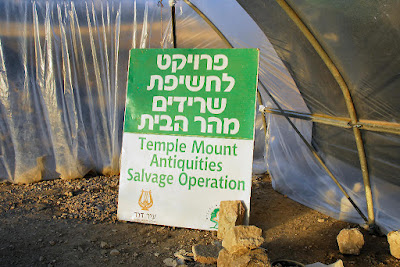
Archaeology, Temple Mount, Jerusalem, archaeological destruction, Israel
http://templemount.wordpress.com/
Last Wednesday we transferred two truckloads of dirt, possibly remains of First and Second Temple garbage dumps, to our sifting site in Emek Zurim Park. On the eastern slopes of the Temple Mount, in the area beneath the Ophel Street, there is a closed garden owned by the Franciscan Church. For a long time I have considered examining these slopes, since I believe they might contain debris from the Temple Mount that washed down after the collapse of the compound walls during the destruction of the First Temple. In addition, I believe that some original Temple dumps might be located at that area.
During the last two weeks major renovations were begun in preparation for a Pontifical Mass that will take place in this area during Pope Benedict’s planned visit to Israel in May. These renovations required some digs into the terraces at the site. These digs are supervised by an Israel Antiquities Authority (IAA) inspector to ensure that no archaeological remains are damaged. At the location where a restroom compound was planned, the contractor dug deep into the terrace, revealing a section of the slope in which various layers could be seen. Among them was a layer of a Second Temple Period dump similar to those on nearby ancient Jerusalem slopes. At the same location, the remains of a human burial were also spotted. For this reason Atra Kadisha, the organization that supervises the handling of ancient Jewish remains, directed the contractor to refill the terrace with the dirt taken out and build a retaining wall to enclose the area.
I was anxious to sample some of soil in the layer beneath the Second Temple Period dump, but realized this might now be impossible since the remains of a human burial were found there. Also, the procedures for obtaining an immediate IAA excavation permit are quite complex. When I revisited the compound on Wednesday, to my surprise I saw that the excavation I was intending to request had already been completed! The contractor at the site had dug a deep foundation trench for the retaining wall required by Atra Kadisha. Upon examining the material removed from this trench, I discovered that the debris from the northern part of the trench contains only First Temple Period pottery! Together with IAA inspector Lara Shluf, we concluded that the trench had penetrated the ancient slope of the Temple Mount from the First Temple Period. The slope included First Temple Period pits full of very large fragments of pottery vessels. Another section of the trench included natural dark brown soil with First Temple Period pottery washed down from higher up the slope. The southern edge of this trench penetrated a Second Temple Period dump, and the northern edge revealed an ancient wall that abuts the bedrock. This wall appears to lie under the First Temple Period layer, and will probably be excavated by the IAA in the near future.
I realized that if the debris that was removed from this trench was not transferred immediately to the sifting site, we might lose this unique opportunity to discover what archaeological remains are hidden within the debris. Unbelievably, but undoubtedly with miraculous Divine help, in less than an hour and a half we managed to get the authorization and help of all the necessary authorities required for such a task – the representative of the Vatican in Israel, the Israel Antiquities Authority, the National Parks Authority, the Atra Kadisha organization, and the Ir David foundation – and we found a contractor to do the job. Obtaining these authorizations is usually a bureaucratic nightmare!
We do not know yet if the material we have brought to the sifting site also contains artifacts that had washed down the slope during the destruction of the First Temple, as this material would have the most promising finds. We will know much more about these unique archaeological remains in the near future. As far as I know, no one has ever studied ancient Iron Age dumps in Jerusalem. The abundance of very high quality “stripe burnished” vessel fragments seen in this dump may indicate that these dumps may come from the Temple Mount itself!
Stay tuned….
No comments:
Post a Comment